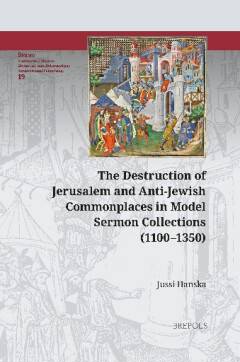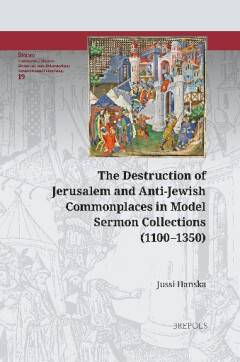
- Afhalen na 1 uur in een winkel met voorraad
- Gratis thuislevering in België vanaf € 30
- Ruim aanbod met 7 miljoen producten
- Afhalen na 1 uur in een winkel met voorraad
- Gratis thuislevering in België vanaf € 30
- Ruim aanbod met 7 miljoen producten
Zoeken
The Destruction of Jerusalem and Anti-Jewish Commonplaces in Model Sermon Collections (1100-1350)
Jussi Hanska
Hardcover | Engels
€ 116,60
+ 233 punten
Omschrijving
This book analyses the diffusion of anti-Judaic stereotypes and topoi in the thirteenth- and early fourteenth-century model sermon collections. It concentrates on the sermons on Luke 19.41-48 where Jesus foretells the Destruction of Jerusalem. The preachers took the view that the Destruction of Jerusalem was divine vengeance for the Jews because they killed Jesus. Thus, these sermons were a good venue for those preachers who wanted to preach against the Jews. Model sermon collections were the closest thing to modern mass media. Consequently, their role in the diffusion of anti-Judaic attitudes was significant. The anti-Judaic writings of the early Church Fathers were only read by few literate church men, whereas model sermons reached the illiterate masses all over the Christianity. Therefore, they played a major role in diffusing anti-Judaic attitudes amongst the population at large and thus contributed to the marginalization of the Jews, to various libels, expulsions, violence, and eventually to large-scale pogroms.
Specificaties
Betrokkenen
- Auteur(s):
- Uitgeverij:
Inhoud
- Aantal bladzijden:
- 346
- Taal:
- Engels
Eigenschappen
- Productcode (EAN):
- 9782503609492
- Verschijningsdatum:
- 20/03/2025
- Uitvoering:
- Hardcover
- Formaat:
- Genaaid
- Gewicht:
- 721 g

Alleen bij Standaard Boekhandel
+ 233 punten op je klantenkaart van Standaard Boekhandel
Beoordelingen
We publiceren alleen reviews die voldoen aan de voorwaarden voor reviews. Bekijk onze voorwaarden voor reviews.








